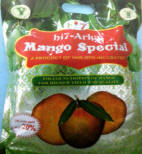|
Mango special:
Due to excessive use of DAP fertilizers and introduction
of high yielding cultivars, deficiency of micronutrients
has become a major problem. However, very few farmers
use micronutrient fertilizers. Balanced nutrition is
very important for high yield, quality and resistance to
diseases. Hence foliar spray comprising secondary and
micronutrients viz., Magnesium, Sulphur, Zinc, Boron,
Iron, Copper, Manganese and Molybdenum is important.
 |
-
Recommended for all
mango varieties
-
Can be mixed with
any fungicide or insecticide
-
Enhances fruit
quality in terms of fruit appearence fruit
keeping quality and taste.
|
Field
trial on Mango special: Field trial was conducted to study
the effect of different micronutrient foliar
formulations on yield and quality of mango variety
Banganapalli. The results showed that application of
IIHR Mango special (during flower bud differentiation,
flower initiation and marble stage of fruit growth) was
effective in improving fruit yield (28.54 kg/tree) and
quality (TSS of
18.9°B).
Major nutrient
requirements of Alphonso mango under rainfed conditions
worked out.
Nutritional requirements of mango cultivars namely
Alphonso and Totapuri were worked out. A dose of 100 g
each of N, P2O5 and K2O/plant/ year of age was found to
be optimum for Alphonso. In case of Totapuri 50 g
N/plant/year of age was found to be optimum whereas, P
and K application did not affect the fruit yield nor
growth of Totapuri mango.
Role of Micronutrient management for production
of export quality Mangoes
Though India is the
highest producer of Mango with largest area, the percent
exported is the lowest. The reason are many Low post
harvest life, lack of varieties with red skin and orange
flesh, regular assured supply (alternate bearing affects
it). Some physiological disorders like spongy tissue,
soft nose, jelly seed are also becoming problems which
affect export and a sound nutrition management can solve
many of the problem to increase export.
Steps to Improve Export of Mango by better Nutrient
Management
-
Avoid Excess Nitrogen – Due to
excess N application to soil or alternate bearing N
builds up in Mango (0.8 – 1.2% leaf Nitrogen) is ideal
INM (30% foliar, 70% Soil) 70% Soil = 35% Organic, 35%
Inorganic.
-
In low pH (konkan) and high pH
Calcareous soil provide P soil or foliar if leaf P is
low 0.08% leaf P. Provide enough P before flowering.
-
Correct Boron deficiency – Boron is
lost by leaching in Konkan soil and unavailable in
Western Maharashtra. B deficiency is most widespread
nutrient disorder in India. Alphonso, Sendura, Rasburi
are highly susceptible. Foliar spray of 0.1% Boric acid
in May, November, December or January and Soil
application of 100g Borax per tree once in 2 years.
It affects fruitset, Fruit drop, Lumpy fruits, Mesocarp
soffening adjacent to stone.
-
Correct Zinc deficiency is the most
important disorder after Boron in Konkan and Western
Maharashtra. Applying 500g Zinc sulphate
once in 3 years foliar spray of 0.3% ZnSO4 in November,
December & January gives satisfactory correction. Iron deficiency is called Lime Induced
chlorosis and it is more in winter, more in
calcareous soil especially in Western Maharashtra,
Marathwada and Vidharbha. FeSO4 0.5% spray corrects it.
-
Increased fruit calcium enhances post
harvest life. In konkan the Aluminium toxicity and
acidic soil reduces Ca uptake. Avoiding excess Nitrogen
and adequate B and foliar spray of 0.5% CaCl2 one month
before harvest provides relief.
-
Better skin & high colour by
adequate K & Mn, and insect resistance & less pesticide
residue.
|